Case Study Analysis: India Power Blackout and Asset Management Issues
VerifiedAdded on 2023/03/30
|17
|3638
|443
Case Study
AI Summary
This case study analyzes the 2012 India power blackout, a major disaster that affected millions due to failures in the NEW grid. The analysis explores the causes, including overdrawal of electricity, poor maintenance, and inadequate asset management. The study examines the problems in the context of the asset life cycle, focusing on definition, design, and operational phases. It highlights the lack of proactive strategies, poor maintenance of the grid, and the failure to implement safety measures like Under Frequency Relays (UFRs). The research uses content and structural analysis to identify key issues and the impact on the Indian economy. The study emphasizes the importance of effective asset management, proactive planning, and adherence to safety protocols to prevent future power crises. The case study includes the introduction, problems, methods, poor maintenance, and conclusion along with recommendations and references.

CASE STUDY ANALYSIS: INDIA POWER BLACKOUT 1
Case Study Analysis: India power blackout
Author’s Name
Professor’s Name
Institutional Affiliation
Course Name
City and State
Date
Case Study Analysis: India power blackout
Author’s Name
Professor’s Name
Institutional Affiliation
Course Name
City and State
Date
Paraphrase This Document
Need a fresh take? Get an instant paraphrase of this document with our AI Paraphraser
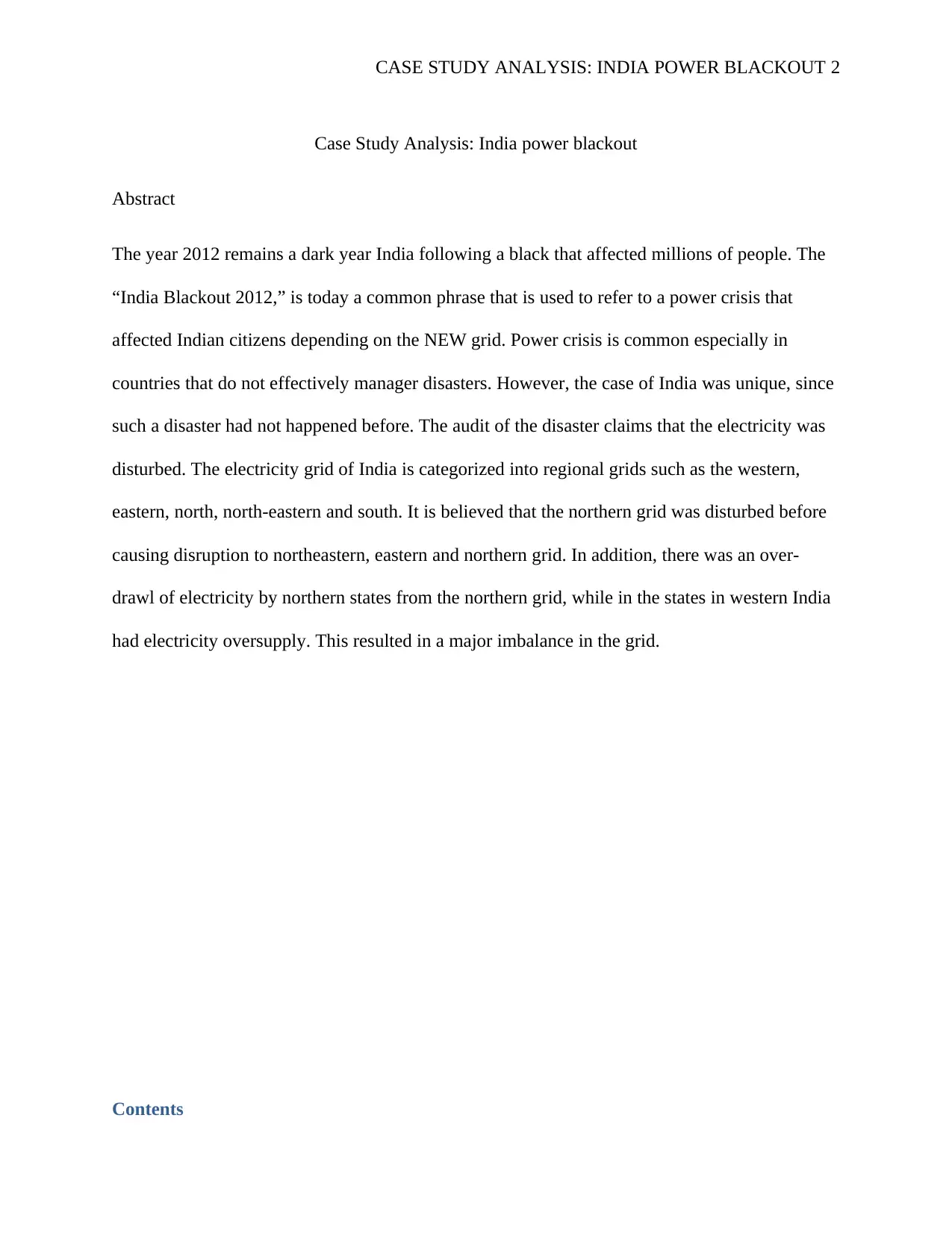
CASE STUDY ANALYSIS: INDIA POWER BLACKOUT 2
Case Study Analysis: India power blackout
Abstract
The year 2012 remains a dark year India following a black that affected millions of people. The
“India Blackout 2012,” is today a common phrase that is used to refer to a power crisis that
affected Indian citizens depending on the NEW grid. Power crisis is common especially in
countries that do not effectively manager disasters. However, the case of India was unique, since
such a disaster had not happened before. The audit of the disaster claims that the electricity was
disturbed. The electricity grid of India is categorized into regional grids such as the western,
eastern, north, north-eastern and south. It is believed that the northern grid was disturbed before
causing disruption to northeastern, eastern and northern grid. In addition, there was an over-
drawl of electricity by northern states from the northern grid, while in the states in western India
had electricity oversupply. This resulted in a major imbalance in the grid.
Contents
Case Study Analysis: India power blackout
Abstract
The year 2012 remains a dark year India following a black that affected millions of people. The
“India Blackout 2012,” is today a common phrase that is used to refer to a power crisis that
affected Indian citizens depending on the NEW grid. Power crisis is common especially in
countries that do not effectively manager disasters. However, the case of India was unique, since
such a disaster had not happened before. The audit of the disaster claims that the electricity was
disturbed. The electricity grid of India is categorized into regional grids such as the western,
eastern, north, north-eastern and south. It is believed that the northern grid was disturbed before
causing disruption to northeastern, eastern and northern grid. In addition, there was an over-
drawl of electricity by northern states from the northern grid, while in the states in western India
had electricity oversupply. This resulted in a major imbalance in the grid.
Contents
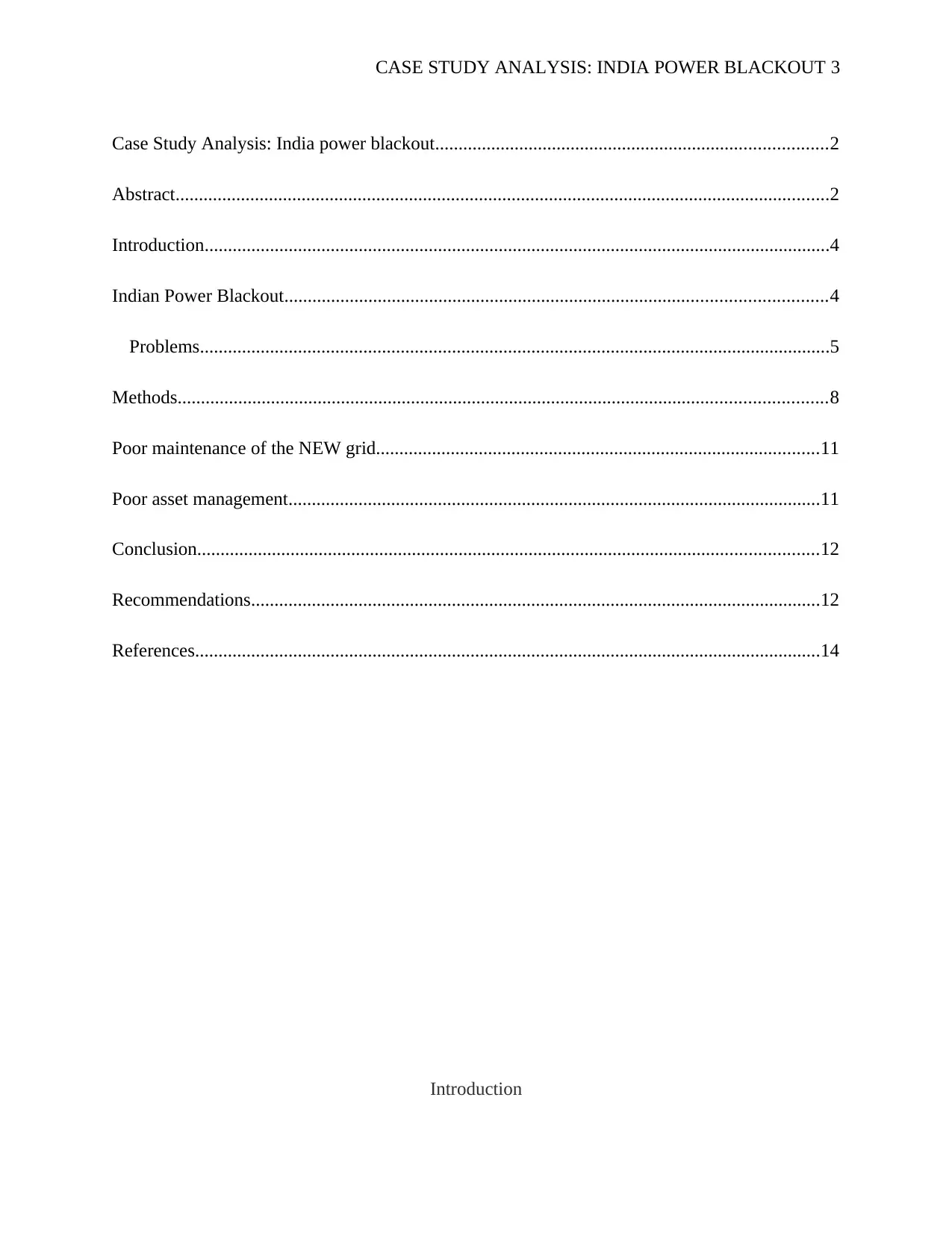
CASE STUDY ANALYSIS: INDIA POWER BLACKOUT 3
Case Study Analysis: India power blackout....................................................................................2
Abstract............................................................................................................................................2
Introduction......................................................................................................................................4
Indian Power Blackout....................................................................................................................4
Problems.......................................................................................................................................5
Methods...........................................................................................................................................8
Poor maintenance of the NEW grid...............................................................................................11
Poor asset management..................................................................................................................11
Conclusion.....................................................................................................................................12
Recommendations..........................................................................................................................12
References......................................................................................................................................14
Introduction
Case Study Analysis: India power blackout....................................................................................2
Abstract............................................................................................................................................2
Introduction......................................................................................................................................4
Indian Power Blackout....................................................................................................................4
Problems.......................................................................................................................................5
Methods...........................................................................................................................................8
Poor maintenance of the NEW grid...............................................................................................11
Poor asset management..................................................................................................................11
Conclusion.....................................................................................................................................12
Recommendations..........................................................................................................................12
References......................................................................................................................................14
Introduction
⊘ This is a preview!⊘
Do you want full access?
Subscribe today to unlock all pages.

Trusted by 1+ million students worldwide
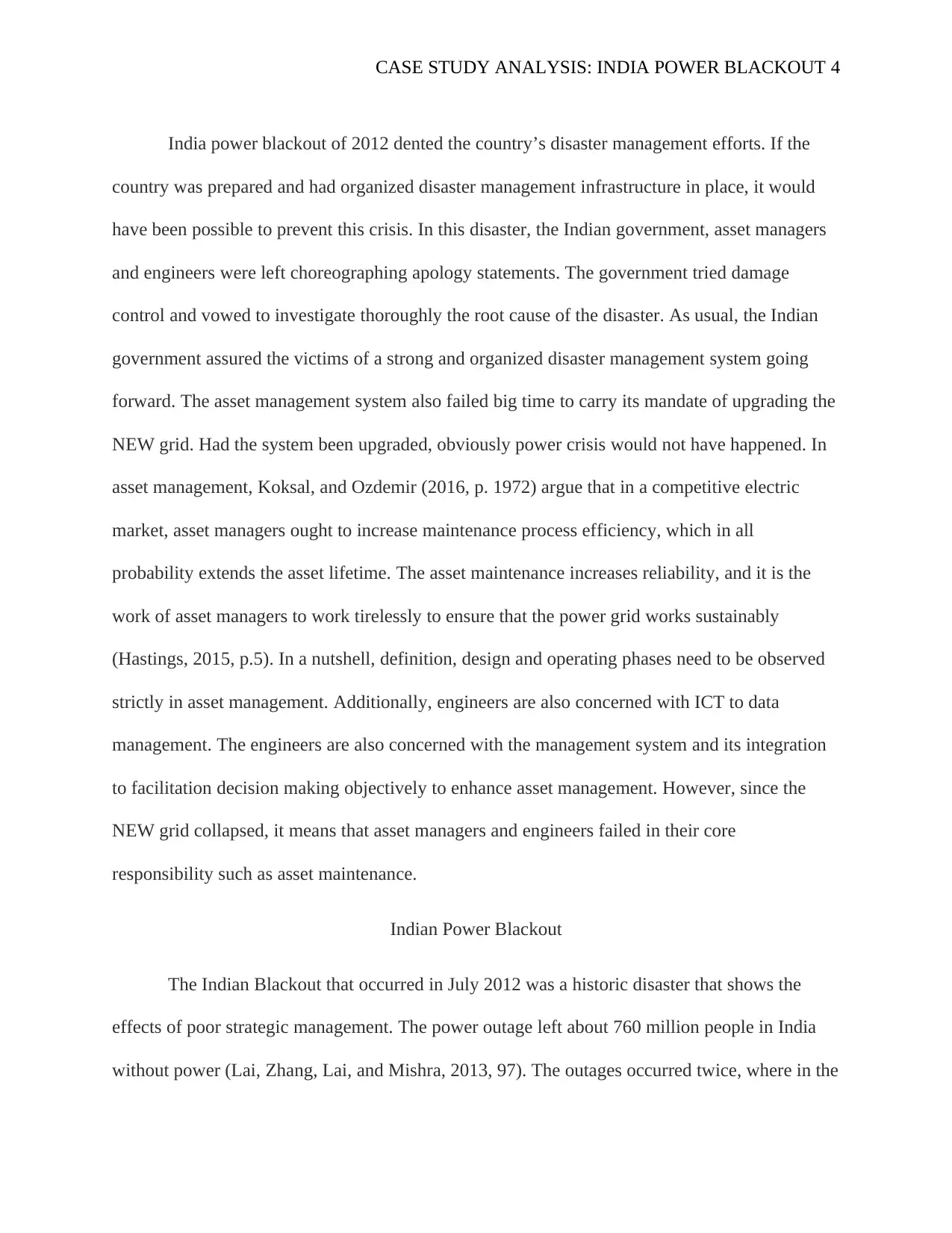
CASE STUDY ANALYSIS: INDIA POWER BLACKOUT 4
India power blackout of 2012 dented the country’s disaster management efforts. If the
country was prepared and had organized disaster management infrastructure in place, it would
have been possible to prevent this crisis. In this disaster, the Indian government, asset managers
and engineers were left choreographing apology statements. The government tried damage
control and vowed to investigate thoroughly the root cause of the disaster. As usual, the Indian
government assured the victims of a strong and organized disaster management system going
forward. The asset management system also failed big time to carry its mandate of upgrading the
NEW grid. Had the system been upgraded, obviously power crisis would not have happened. In
asset management, Koksal, and Ozdemir (2016, p. 1972) argue that in a competitive electric
market, asset managers ought to increase maintenance process efficiency, which in all
probability extends the asset lifetime. The asset maintenance increases reliability, and it is the
work of asset managers to work tirelessly to ensure that the power grid works sustainably
(Hastings, 2015, p.5). In a nutshell, definition, design and operating phases need to be observed
strictly in asset management. Additionally, engineers are also concerned with ICT to data
management. The engineers are also concerned with the management system and its integration
to facilitation decision making objectively to enhance asset management. However, since the
NEW grid collapsed, it means that asset managers and engineers failed in their core
responsibility such as asset maintenance.
Indian Power Blackout
The Indian Blackout that occurred in July 2012 was a historic disaster that shows the
effects of poor strategic management. The power outage left about 760 million people in India
without power (Lai, Zhang, Lai, and Mishra, 2013, 97). The outages occurred twice, where in the
India power blackout of 2012 dented the country’s disaster management efforts. If the
country was prepared and had organized disaster management infrastructure in place, it would
have been possible to prevent this crisis. In this disaster, the Indian government, asset managers
and engineers were left choreographing apology statements. The government tried damage
control and vowed to investigate thoroughly the root cause of the disaster. As usual, the Indian
government assured the victims of a strong and organized disaster management system going
forward. The asset management system also failed big time to carry its mandate of upgrading the
NEW grid. Had the system been upgraded, obviously power crisis would not have happened. In
asset management, Koksal, and Ozdemir (2016, p. 1972) argue that in a competitive electric
market, asset managers ought to increase maintenance process efficiency, which in all
probability extends the asset lifetime. The asset maintenance increases reliability, and it is the
work of asset managers to work tirelessly to ensure that the power grid works sustainably
(Hastings, 2015, p.5). In a nutshell, definition, design and operating phases need to be observed
strictly in asset management. Additionally, engineers are also concerned with ICT to data
management. The engineers are also concerned with the management system and its integration
to facilitation decision making objectively to enhance asset management. However, since the
NEW grid collapsed, it means that asset managers and engineers failed in their core
responsibility such as asset maintenance.
Indian Power Blackout
The Indian Blackout that occurred in July 2012 was a historic disaster that shows the
effects of poor strategic management. The power outage left about 760 million people in India
without power (Lai, Zhang, Lai, and Mishra, 2013, 97). The outages occurred twice, where in the
Paraphrase This Document
Need a fresh take? Get an instant paraphrase of this document with our AI Paraphraser
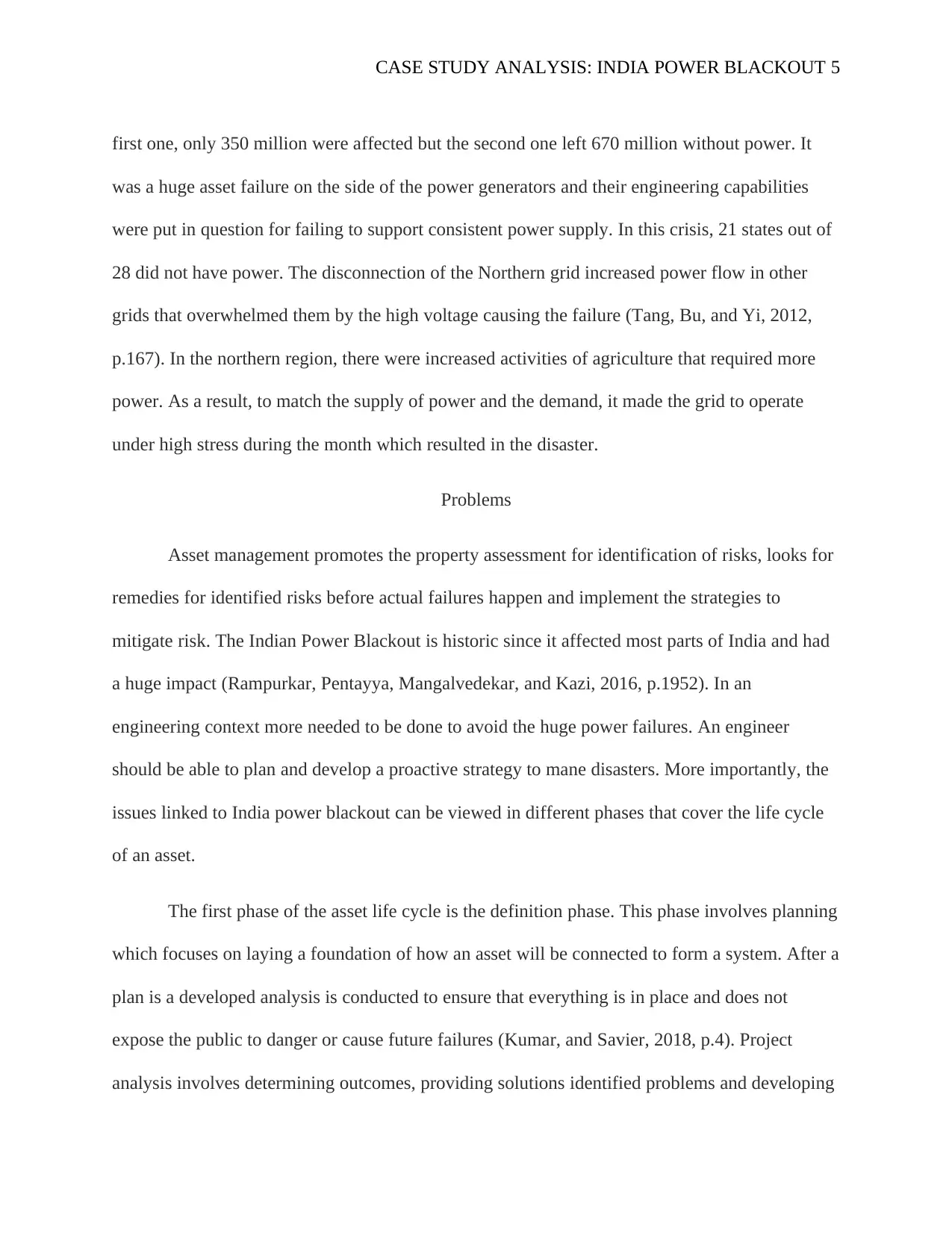
CASE STUDY ANALYSIS: INDIA POWER BLACKOUT 5
first one, only 350 million were affected but the second one left 670 million without power. It
was a huge asset failure on the side of the power generators and their engineering capabilities
were put in question for failing to support consistent power supply. In this crisis, 21 states out of
28 did not have power. The disconnection of the Northern grid increased power flow in other
grids that overwhelmed them by the high voltage causing the failure (Tang, Bu, and Yi, 2012,
p.167). In the northern region, there were increased activities of agriculture that required more
power. As a result, to match the supply of power and the demand, it made the grid to operate
under high stress during the month which resulted in the disaster.
Problems
Asset management promotes the property assessment for identification of risks, looks for
remedies for identified risks before actual failures happen and implement the strategies to
mitigate risk. The Indian Power Blackout is historic since it affected most parts of India and had
a huge impact (Rampurkar, Pentayya, Mangalvedekar, and Kazi, 2016, p.1952). In an
engineering context more needed to be done to avoid the huge power failures. An engineer
should be able to plan and develop a proactive strategy to mane disasters. More importantly, the
issues linked to India power blackout can be viewed in different phases that cover the life cycle
of an asset.
The first phase of the asset life cycle is the definition phase. This phase involves planning
which focuses on laying a foundation of how an asset will be connected to form a system. After a
plan is a developed analysis is conducted to ensure that everything is in place and does not
expose the public to danger or cause future failures (Kumar, and Savier, 2018, p.4). Project
analysis involves determining outcomes, providing solutions identified problems and developing
first one, only 350 million were affected but the second one left 670 million without power. It
was a huge asset failure on the side of the power generators and their engineering capabilities
were put in question for failing to support consistent power supply. In this crisis, 21 states out of
28 did not have power. The disconnection of the Northern grid increased power flow in other
grids that overwhelmed them by the high voltage causing the failure (Tang, Bu, and Yi, 2012,
p.167). In the northern region, there were increased activities of agriculture that required more
power. As a result, to match the supply of power and the demand, it made the grid to operate
under high stress during the month which resulted in the disaster.
Problems
Asset management promotes the property assessment for identification of risks, looks for
remedies for identified risks before actual failures happen and implement the strategies to
mitigate risk. The Indian Power Blackout is historic since it affected most parts of India and had
a huge impact (Rampurkar, Pentayya, Mangalvedekar, and Kazi, 2016, p.1952). In an
engineering context more needed to be done to avoid the huge power failures. An engineer
should be able to plan and develop a proactive strategy to mane disasters. More importantly, the
issues linked to India power blackout can be viewed in different phases that cover the life cycle
of an asset.
The first phase of the asset life cycle is the definition phase. This phase involves planning
which focuses on laying a foundation of how an asset will be connected to form a system. After a
plan is a developed analysis is conducted to ensure that everything is in place and does not
expose the public to danger or cause future failures (Kumar, and Savier, 2018, p.4). Project
analysis involves determining outcomes, providing solutions identified problems and developing
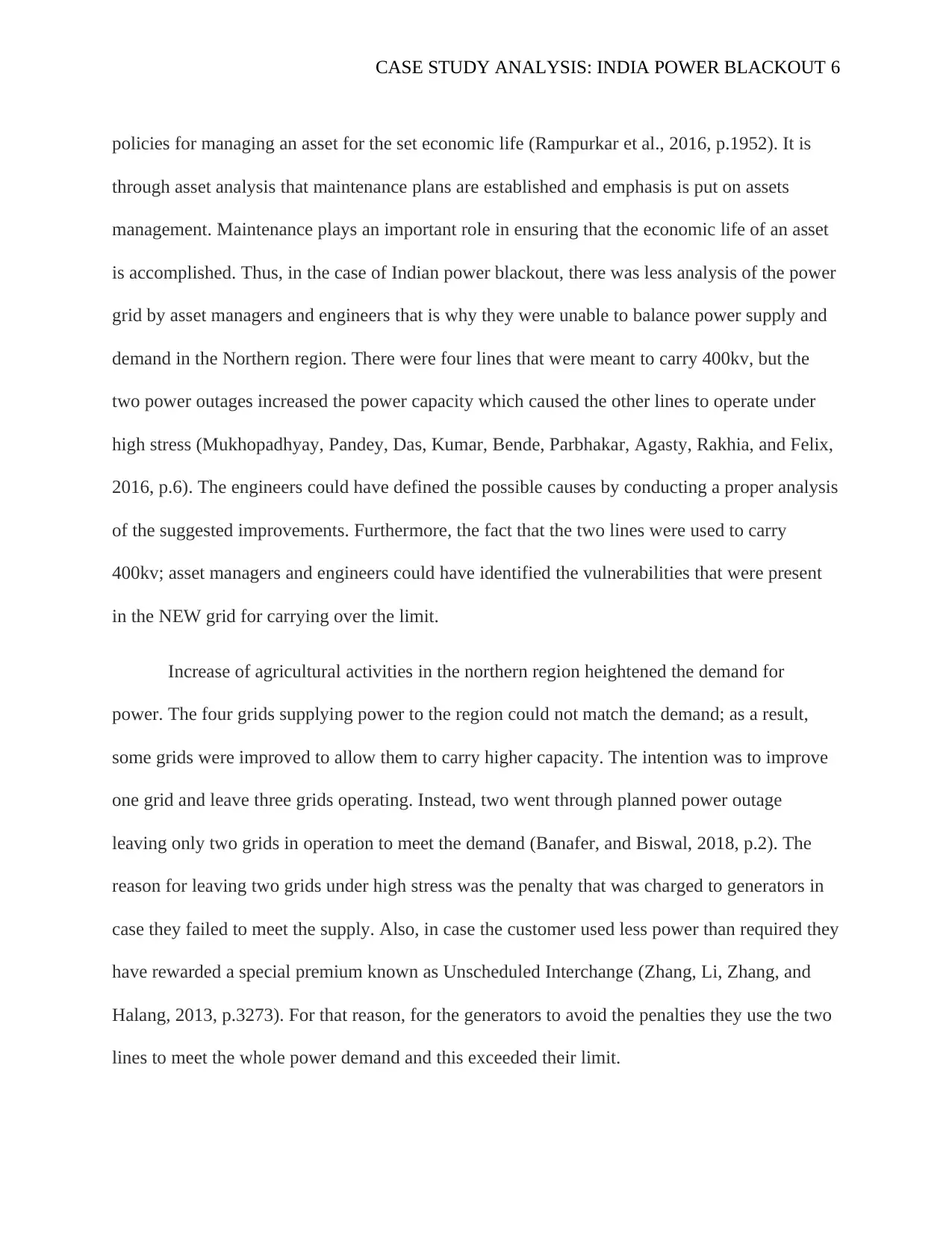
CASE STUDY ANALYSIS: INDIA POWER BLACKOUT 6
policies for managing an asset for the set economic life (Rampurkar et al., 2016, p.1952). It is
through asset analysis that maintenance plans are established and emphasis is put on assets
management. Maintenance plays an important role in ensuring that the economic life of an asset
is accomplished. Thus, in the case of Indian power blackout, there was less analysis of the power
grid by asset managers and engineers that is why they were unable to balance power supply and
demand in the Northern region. There were four lines that were meant to carry 400kv, but the
two power outages increased the power capacity which caused the other lines to operate under
high stress (Mukhopadhyay, Pandey, Das, Kumar, Bende, Parbhakar, Agasty, Rakhia, and Felix,
2016, p.6). The engineers could have defined the possible causes by conducting a proper analysis
of the suggested improvements. Furthermore, the fact that the two lines were used to carry
400kv; asset managers and engineers could have identified the vulnerabilities that were present
in the NEW grid for carrying over the limit.
Increase of agricultural activities in the northern region heightened the demand for
power. The four grids supplying power to the region could not match the demand; as a result,
some grids were improved to allow them to carry higher capacity. The intention was to improve
one grid and leave three grids operating. Instead, two went through planned power outage
leaving only two grids in operation to meet the demand (Banafer, and Biswal, 2018, p.2). The
reason for leaving two grids under high stress was the penalty that was charged to generators in
case they failed to meet the supply. Also, in case the customer used less power than required they
have rewarded a special premium known as Unscheduled Interchange (Zhang, Li, Zhang, and
Halang, 2013, p.3273). For that reason, for the generators to avoid the penalties they use the two
lines to meet the whole power demand and this exceeded their limit.
policies for managing an asset for the set economic life (Rampurkar et al., 2016, p.1952). It is
through asset analysis that maintenance plans are established and emphasis is put on assets
management. Maintenance plays an important role in ensuring that the economic life of an asset
is accomplished. Thus, in the case of Indian power blackout, there was less analysis of the power
grid by asset managers and engineers that is why they were unable to balance power supply and
demand in the Northern region. There were four lines that were meant to carry 400kv, but the
two power outages increased the power capacity which caused the other lines to operate under
high stress (Mukhopadhyay, Pandey, Das, Kumar, Bende, Parbhakar, Agasty, Rakhia, and Felix,
2016, p.6). The engineers could have defined the possible causes by conducting a proper analysis
of the suggested improvements. Furthermore, the fact that the two lines were used to carry
400kv; asset managers and engineers could have identified the vulnerabilities that were present
in the NEW grid for carrying over the limit.
Increase of agricultural activities in the northern region heightened the demand for
power. The four grids supplying power to the region could not match the demand; as a result,
some grids were improved to allow them to carry higher capacity. The intention was to improve
one grid and leave three grids operating. Instead, two went through planned power outage
leaving only two grids in operation to meet the demand (Banafer, and Biswal, 2018, p.2). The
reason for leaving two grids under high stress was the penalty that was charged to generators in
case they failed to meet the supply. Also, in case the customer used less power than required they
have rewarded a special premium known as Unscheduled Interchange (Zhang, Li, Zhang, and
Halang, 2013, p.3273). For that reason, for the generators to avoid the penalties they use the two
lines to meet the whole power demand and this exceeded their limit.
⊘ This is a preview!⊘
Do you want full access?
Subscribe today to unlock all pages.

Trusted by 1+ million students worldwide
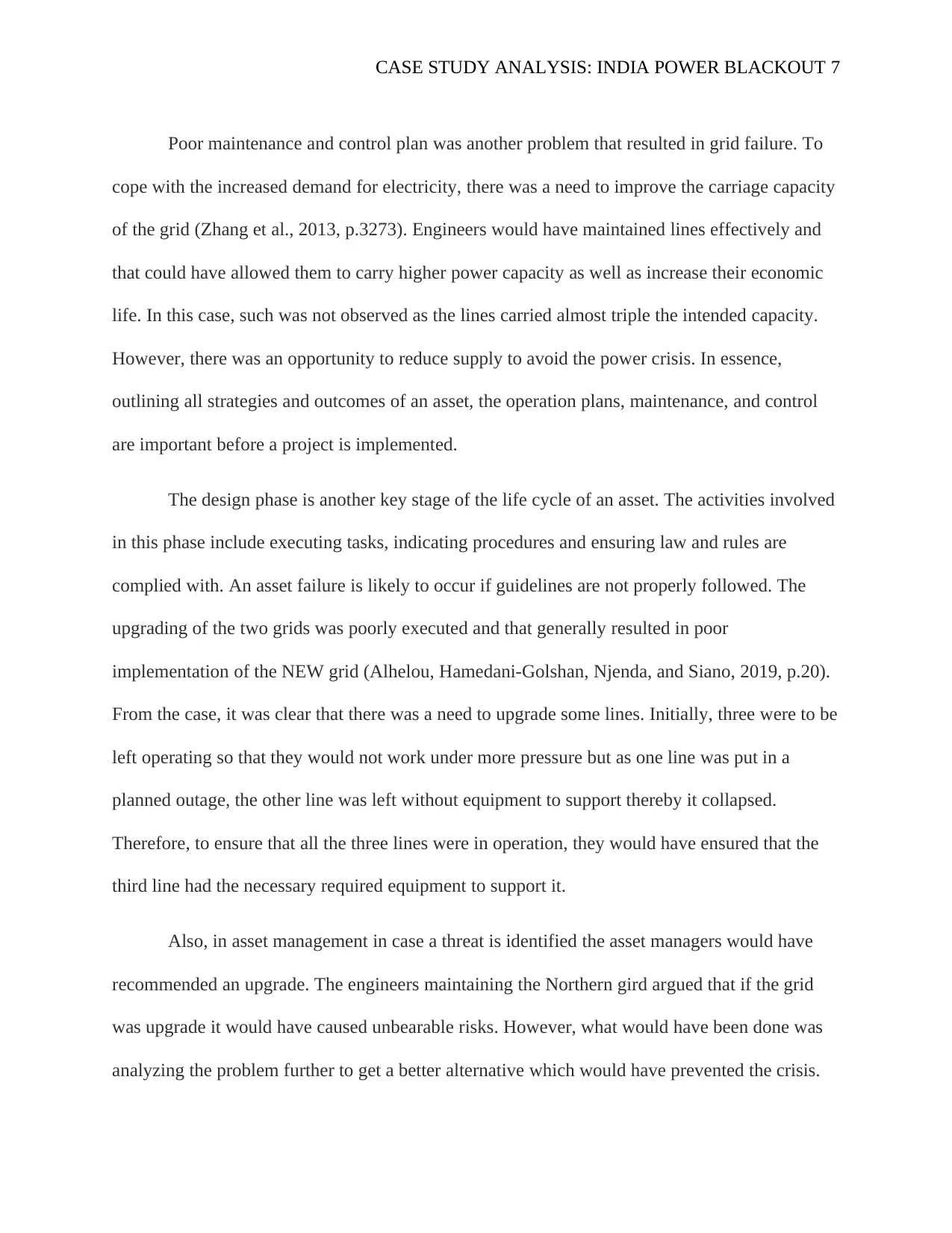
CASE STUDY ANALYSIS: INDIA POWER BLACKOUT 7
Poor maintenance and control plan was another problem that resulted in grid failure. To
cope with the increased demand for electricity, there was a need to improve the carriage capacity
of the grid (Zhang et al., 2013, p.3273). Engineers would have maintained lines effectively and
that could have allowed them to carry higher power capacity as well as increase their economic
life. In this case, such was not observed as the lines carried almost triple the intended capacity.
However, there was an opportunity to reduce supply to avoid the power crisis. In essence,
outlining all strategies and outcomes of an asset, the operation plans, maintenance, and control
are important before a project is implemented.
The design phase is another key stage of the life cycle of an asset. The activities involved
in this phase include executing tasks, indicating procedures and ensuring law and rules are
complied with. An asset failure is likely to occur if guidelines are not properly followed. The
upgrading of the two grids was poorly executed and that generally resulted in poor
implementation of the NEW grid (Alhelou, Hamedani-Golshan, Njenda, and Siano, 2019, p.20).
From the case, it was clear that there was a need to upgrade some lines. Initially, three were to be
left operating so that they would not work under more pressure but as one line was put in a
planned outage, the other line was left without equipment to support thereby it collapsed.
Therefore, to ensure that all the three lines were in operation, they would have ensured that the
third line had the necessary required equipment to support it.
Also, in asset management in case a threat is identified the asset managers would have
recommended an upgrade. The engineers maintaining the Northern gird argued that if the grid
was upgrade it would have caused unbearable risks. However, what would have been done was
analyzing the problem further to get a better alternative which would have prevented the crisis.
Poor maintenance and control plan was another problem that resulted in grid failure. To
cope with the increased demand for electricity, there was a need to improve the carriage capacity
of the grid (Zhang et al., 2013, p.3273). Engineers would have maintained lines effectively and
that could have allowed them to carry higher power capacity as well as increase their economic
life. In this case, such was not observed as the lines carried almost triple the intended capacity.
However, there was an opportunity to reduce supply to avoid the power crisis. In essence,
outlining all strategies and outcomes of an asset, the operation plans, maintenance, and control
are important before a project is implemented.
The design phase is another key stage of the life cycle of an asset. The activities involved
in this phase include executing tasks, indicating procedures and ensuring law and rules are
complied with. An asset failure is likely to occur if guidelines are not properly followed. The
upgrading of the two grids was poorly executed and that generally resulted in poor
implementation of the NEW grid (Alhelou, Hamedani-Golshan, Njenda, and Siano, 2019, p.20).
From the case, it was clear that there was a need to upgrade some lines. Initially, three were to be
left operating so that they would not work under more pressure but as one line was put in a
planned outage, the other line was left without equipment to support thereby it collapsed.
Therefore, to ensure that all the three lines were in operation, they would have ensured that the
third line had the necessary required equipment to support it.
Also, in asset management in case a threat is identified the asset managers would have
recommended an upgrade. The engineers maintaining the Northern gird argued that if the grid
was upgrade it would have caused unbearable risks. However, what would have been done was
analyzing the problem further to get a better alternative which would have prevented the crisis.
Paraphrase This Document
Need a fresh take? Get an instant paraphrase of this document with our AI Paraphraser

CASE STUDY ANALYSIS: INDIA POWER BLACKOUT 8
Also, the proposal to use Under Frequency Relays (UFRs) was ignored and it would have been
important if it was implemented to curtail the power load to minimize cases of outages
(Mansouri, Nayeripour, and Negnevitsky, 2016, p.840). There was less compliance with such
safety rules due to self-interest of a group of people due to socio-political pressure. The failure to
implement UFRs contributed to non-compliance with load curtailment which then disturbed the
grid before the blackout struck. The forced outage of two lines led to the increased stress of the
other lines. Unfortunately, their consequences were not considered since nobody believed they
could cause failure to the entire grid. Also, poor work procedure was seen in the collapse of
Agra-Gwalior line which had occurred 36 hours to the major blackout (Blankenship, and
Urpelainen, 2016, p.3). It gave a signal to the upgrade but it was ignored, hence leading to India
power blackout of 2012.
The third phase of the life cycle asset is operating phase. It is at this phase that the
blackout happened. This stage involves technical performance and inspection of the assets. The
lines supplying power in the Northern region which was hit by power crisis needed to have
protective devices that would detect when the power capacity was extremely high or low. The
protective device that was proposed was Under Frequency Relays to detect the dispatch load of
each line (Mansouri et al., 2016.p, 840). In case the loads were too high, it could give signals that
the generators would correct the capacity released to the grids. The state utilities drew power
from the grid even when the system was compromised increasing danger to the system. If the
UFRs were installed, it would have improved the system management and ensured the right
loads were dispatched (Gonzalez-Longatt, 2016, p.211).
Methods
Also, the proposal to use Under Frequency Relays (UFRs) was ignored and it would have been
important if it was implemented to curtail the power load to minimize cases of outages
(Mansouri, Nayeripour, and Negnevitsky, 2016, p.840). There was less compliance with such
safety rules due to self-interest of a group of people due to socio-political pressure. The failure to
implement UFRs contributed to non-compliance with load curtailment which then disturbed the
grid before the blackout struck. The forced outage of two lines led to the increased stress of the
other lines. Unfortunately, their consequences were not considered since nobody believed they
could cause failure to the entire grid. Also, poor work procedure was seen in the collapse of
Agra-Gwalior line which had occurred 36 hours to the major blackout (Blankenship, and
Urpelainen, 2016, p.3). It gave a signal to the upgrade but it was ignored, hence leading to India
power blackout of 2012.
The third phase of the life cycle asset is operating phase. It is at this phase that the
blackout happened. This stage involves technical performance and inspection of the assets. The
lines supplying power in the Northern region which was hit by power crisis needed to have
protective devices that would detect when the power capacity was extremely high or low. The
protective device that was proposed was Under Frequency Relays to detect the dispatch load of
each line (Mansouri et al., 2016.p, 840). In case the loads were too high, it could give signals that
the generators would correct the capacity released to the grids. The state utilities drew power
from the grid even when the system was compromised increasing danger to the system. If the
UFRs were installed, it would have improved the system management and ensured the right
loads were dispatched (Gonzalez-Longatt, 2016, p.211).
Methods
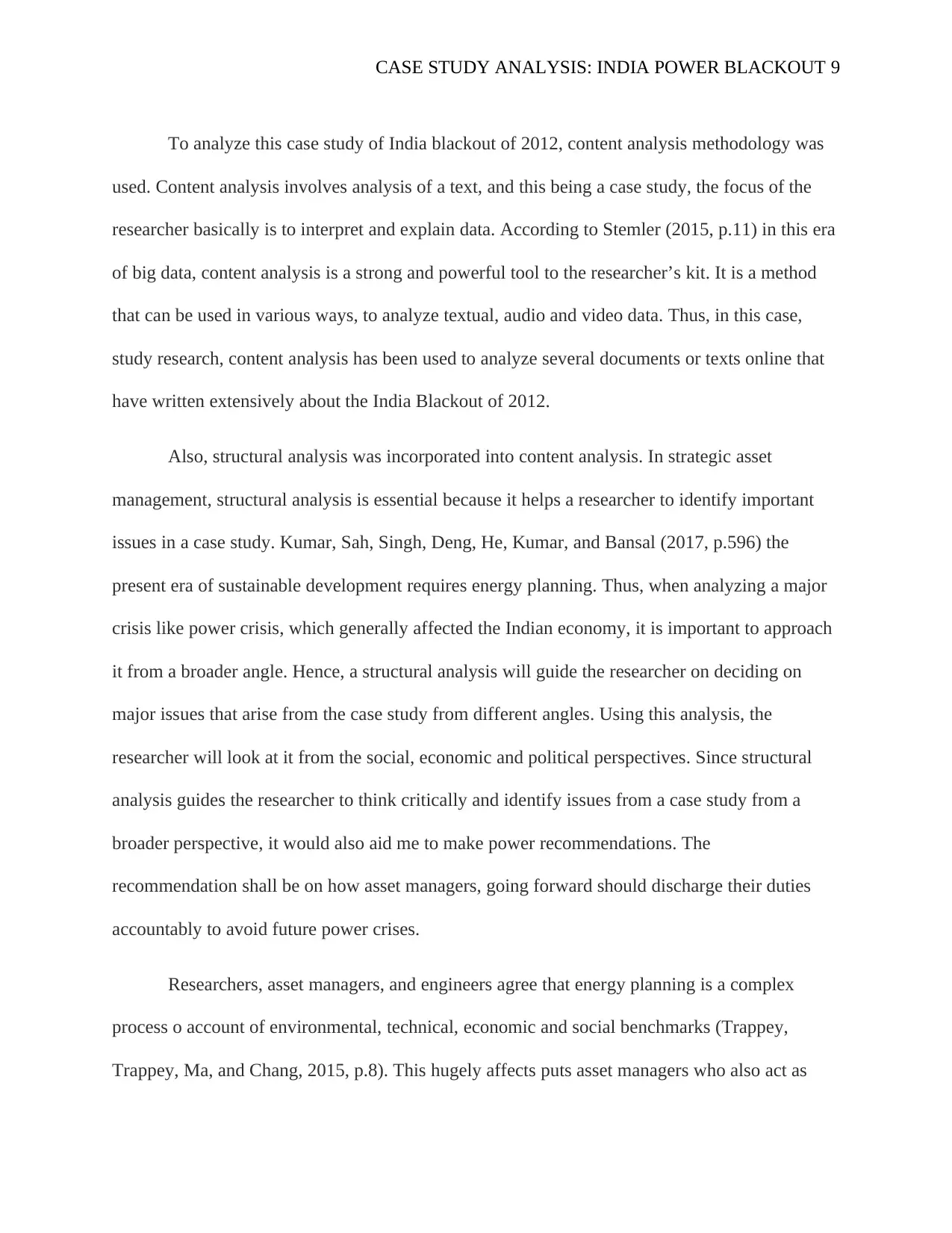
CASE STUDY ANALYSIS: INDIA POWER BLACKOUT 9
To analyze this case study of India blackout of 2012, content analysis methodology was
used. Content analysis involves analysis of a text, and this being a case study, the focus of the
researcher basically is to interpret and explain data. According to Stemler (2015, p.11) in this era
of big data, content analysis is a strong and powerful tool to the researcher’s kit. It is a method
that can be used in various ways, to analyze textual, audio and video data. Thus, in this case,
study research, content analysis has been used to analyze several documents or texts online that
have written extensively about the India Blackout of 2012.
Also, structural analysis was incorporated into content analysis. In strategic asset
management, structural analysis is essential because it helps a researcher to identify important
issues in a case study. Kumar, Sah, Singh, Deng, He, Kumar, and Bansal (2017, p.596) the
present era of sustainable development requires energy planning. Thus, when analyzing a major
crisis like power crisis, which generally affected the Indian economy, it is important to approach
it from a broader angle. Hence, a structural analysis will guide the researcher on deciding on
major issues that arise from the case study from different angles. Using this analysis, the
researcher will look at it from the social, economic and political perspectives. Since structural
analysis guides the researcher to think critically and identify issues from a case study from a
broader perspective, it would also aid me to make power recommendations. The
recommendation shall be on how asset managers, going forward should discharge their duties
accountably to avoid future power crises.
Researchers, asset managers, and engineers agree that energy planning is a complex
process o account of environmental, technical, economic and social benchmarks (Trappey,
Trappey, Ma, and Chang, 2015, p.8). This hugely affects puts asset managers who also act as
To analyze this case study of India blackout of 2012, content analysis methodology was
used. Content analysis involves analysis of a text, and this being a case study, the focus of the
researcher basically is to interpret and explain data. According to Stemler (2015, p.11) in this era
of big data, content analysis is a strong and powerful tool to the researcher’s kit. It is a method
that can be used in various ways, to analyze textual, audio and video data. Thus, in this case,
study research, content analysis has been used to analyze several documents or texts online that
have written extensively about the India Blackout of 2012.
Also, structural analysis was incorporated into content analysis. In strategic asset
management, structural analysis is essential because it helps a researcher to identify important
issues in a case study. Kumar, Sah, Singh, Deng, He, Kumar, and Bansal (2017, p.596) the
present era of sustainable development requires energy planning. Thus, when analyzing a major
crisis like power crisis, which generally affected the Indian economy, it is important to approach
it from a broader angle. Hence, a structural analysis will guide the researcher on deciding on
major issues that arise from the case study from different angles. Using this analysis, the
researcher will look at it from the social, economic and political perspectives. Since structural
analysis guides the researcher to think critically and identify issues from a case study from a
broader perspective, it would also aid me to make power recommendations. The
recommendation shall be on how asset managers, going forward should discharge their duties
accountably to avoid future power crises.
Researchers, asset managers, and engineers agree that energy planning is a complex
process o account of environmental, technical, economic and social benchmarks (Trappey,
Trappey, Ma, and Chang, 2015, p.8). This hugely affects puts asset managers who also act as
⊘ This is a preview!⊘
Do you want full access?
Subscribe today to unlock all pages.

Trusted by 1+ million students worldwide
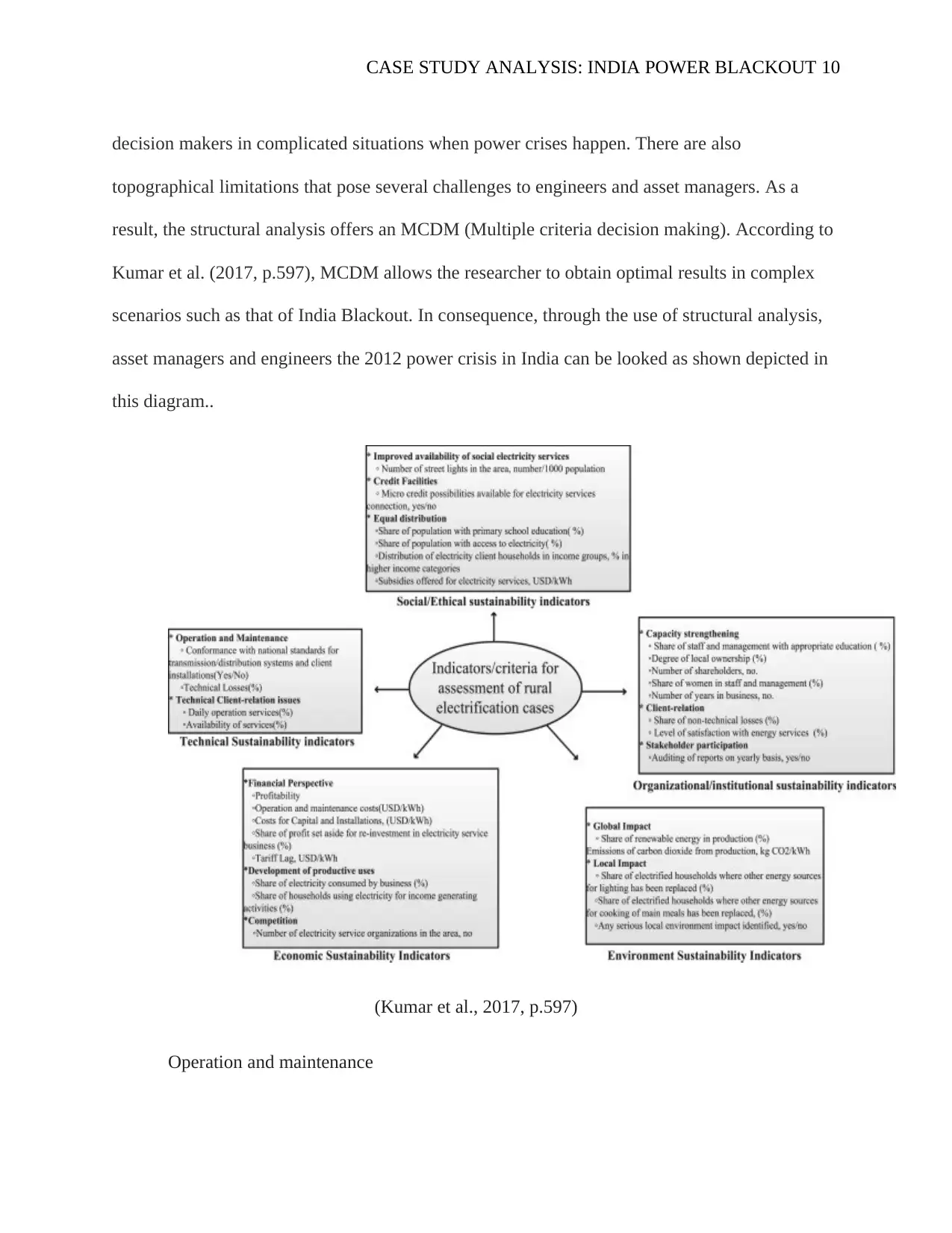
CASE STUDY ANALYSIS: INDIA POWER BLACKOUT 10
decision makers in complicated situations when power crises happen. There are also
topographical limitations that pose several challenges to engineers and asset managers. As a
result, the structural analysis offers an MCDM (Multiple criteria decision making). According to
Kumar et al. (2017, p.597), MCDM allows the researcher to obtain optimal results in complex
scenarios such as that of India Blackout. In consequence, through the use of structural analysis,
asset managers and engineers the 2012 power crisis in India can be looked as shown depicted in
this diagram..
(Kumar et al., 2017, p.597)
Operation and maintenance
decision makers in complicated situations when power crises happen. There are also
topographical limitations that pose several challenges to engineers and asset managers. As a
result, the structural analysis offers an MCDM (Multiple criteria decision making). According to
Kumar et al. (2017, p.597), MCDM allows the researcher to obtain optimal results in complex
scenarios such as that of India Blackout. In consequence, through the use of structural analysis,
asset managers and engineers the 2012 power crisis in India can be looked as shown depicted in
this diagram..
(Kumar et al., 2017, p.597)
Operation and maintenance
Paraphrase This Document
Need a fresh take? Get an instant paraphrase of this document with our AI Paraphraser
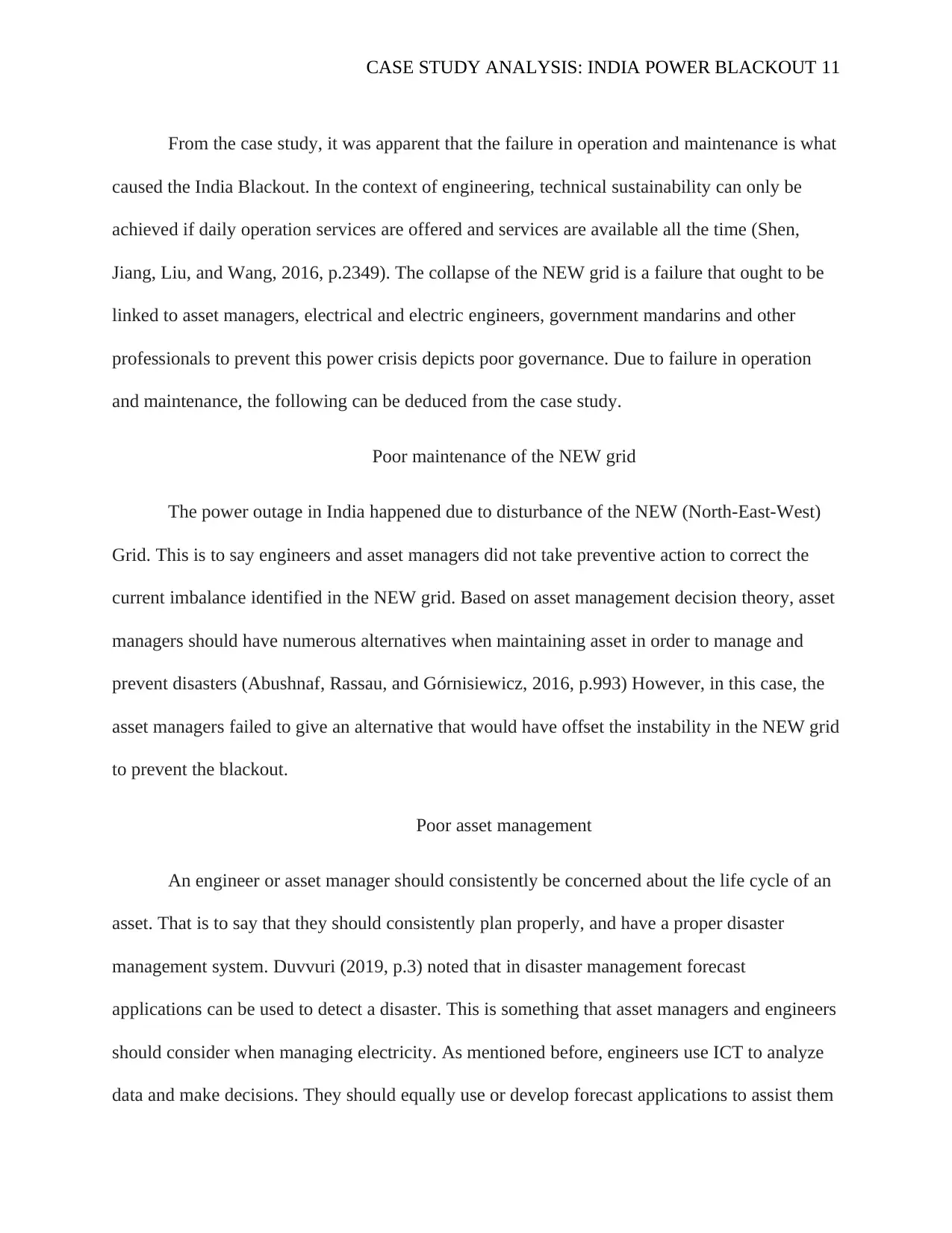
CASE STUDY ANALYSIS: INDIA POWER BLACKOUT 11
From the case study, it was apparent that the failure in operation and maintenance is what
caused the India Blackout. In the context of engineering, technical sustainability can only be
achieved if daily operation services are offered and services are available all the time (Shen,
Jiang, Liu, and Wang, 2016, p.2349). The collapse of the NEW grid is a failure that ought to be
linked to asset managers, electrical and electric engineers, government mandarins and other
professionals to prevent this power crisis depicts poor governance. Due to failure in operation
and maintenance, the following can be deduced from the case study.
Poor maintenance of the NEW grid
The power outage in India happened due to disturbance of the NEW (North-East-West)
Grid. This is to say engineers and asset managers did not take preventive action to correct the
current imbalance identified in the NEW grid. Based on asset management decision theory, asset
managers should have numerous alternatives when maintaining asset in order to manage and
prevent disasters (Abushnaf, Rassau, and Górnisiewicz, 2016, p.993) However, in this case, the
asset managers failed to give an alternative that would have offset the instability in the NEW grid
to prevent the blackout.
Poor asset management
An engineer or asset manager should consistently be concerned about the life cycle of an
asset. That is to say that they should consistently plan properly, and have a proper disaster
management system. Duvvuri (2019, p.3) noted that in disaster management forecast
applications can be used to detect a disaster. This is something that asset managers and engineers
should consider when managing electricity. As mentioned before, engineers use ICT to analyze
data and make decisions. They should equally use or develop forecast applications to assist them
From the case study, it was apparent that the failure in operation and maintenance is what
caused the India Blackout. In the context of engineering, technical sustainability can only be
achieved if daily operation services are offered and services are available all the time (Shen,
Jiang, Liu, and Wang, 2016, p.2349). The collapse of the NEW grid is a failure that ought to be
linked to asset managers, electrical and electric engineers, government mandarins and other
professionals to prevent this power crisis depicts poor governance. Due to failure in operation
and maintenance, the following can be deduced from the case study.
Poor maintenance of the NEW grid
The power outage in India happened due to disturbance of the NEW (North-East-West)
Grid. This is to say engineers and asset managers did not take preventive action to correct the
current imbalance identified in the NEW grid. Based on asset management decision theory, asset
managers should have numerous alternatives when maintaining asset in order to manage and
prevent disasters (Abushnaf, Rassau, and Górnisiewicz, 2016, p.993) However, in this case, the
asset managers failed to give an alternative that would have offset the instability in the NEW grid
to prevent the blackout.
Poor asset management
An engineer or asset manager should consistently be concerned about the life cycle of an
asset. That is to say that they should consistently plan properly, and have a proper disaster
management system. Duvvuri (2019, p.3) noted that in disaster management forecast
applications can be used to detect a disaster. This is something that asset managers and engineers
should consider when managing electricity. As mentioned before, engineers use ICT to analyze
data and make decisions. They should equally use or develop forecast applications to assist them

CASE STUDY ANALYSIS: INDIA POWER BLACKOUT 12
to identify future problems that are likely to arise from the NEW grid (Tripathy, Sajjad, Elvidge,
Ting, Pandey, Rani, and Kumar, 2018, p.617). Essentially, the power crisis would not have
occurred if the asset managers and engineers with the support of the Indian government would
have developed a reliable disaster management system.
Asset management decision theory insist that for an asset to be managed properly the
asset managers ought to focus on minimizing costs and improving efficiency. That is said, right
decisions on planning, operation and maintenance were not made and that is why the Indian
blackout occurred (Huynh, Robu, Flynn, Rowland, and Coapes, 2017, p.105). Thus, the India
blackout occurred due to asset managers’ inability or lack of commit to sustaining reliability,
availability, and maintainability of the NEW grid.
Conclusion
From the incident experience in India on power blackout, risk mitigation during the
upgrade of the system or installation of power remains relevant in asset management. Assessing
risks during the implementation of a project is key in preventing disasters from occurring. Some
of the key issues that were witnessed from the analysis are non-compliance of rules, poor
planning, power generators trying to avoid penalties and heavy load dispatch. The incident was
also contributed by the Indian government to some level for allowing people to draw power from
a compromised system and failure to install the UFRs in the upgrade of the NEW grid.
Therefore, it is important in future for an asset manager to get resources necessary for
maintenance and upgrades to avoid huge blackout or system failure.
Recommendations
to identify future problems that are likely to arise from the NEW grid (Tripathy, Sajjad, Elvidge,
Ting, Pandey, Rani, and Kumar, 2018, p.617). Essentially, the power crisis would not have
occurred if the asset managers and engineers with the support of the Indian government would
have developed a reliable disaster management system.
Asset management decision theory insist that for an asset to be managed properly the
asset managers ought to focus on minimizing costs and improving efficiency. That is said, right
decisions on planning, operation and maintenance were not made and that is why the Indian
blackout occurred (Huynh, Robu, Flynn, Rowland, and Coapes, 2017, p.105). Thus, the India
blackout occurred due to asset managers’ inability or lack of commit to sustaining reliability,
availability, and maintainability of the NEW grid.
Conclusion
From the incident experience in India on power blackout, risk mitigation during the
upgrade of the system or installation of power remains relevant in asset management. Assessing
risks during the implementation of a project is key in preventing disasters from occurring. Some
of the key issues that were witnessed from the analysis are non-compliance of rules, poor
planning, power generators trying to avoid penalties and heavy load dispatch. The incident was
also contributed by the Indian government to some level for allowing people to draw power from
a compromised system and failure to install the UFRs in the upgrade of the NEW grid.
Therefore, it is important in future for an asset manager to get resources necessary for
maintenance and upgrades to avoid huge blackout or system failure.
Recommendations
⊘ This is a preview!⊘
Do you want full access?
Subscribe today to unlock all pages.

Trusted by 1+ million students worldwide
1 out of 17
Related Documents
Your All-in-One AI-Powered Toolkit for Academic Success.
+13062052269
info@desklib.com
Available 24*7 on WhatsApp / Email
![[object Object]](/_next/static/media/star-bottom.7253800d.svg)
Unlock your academic potential
Copyright © 2020–2025 A2Z Services. All Rights Reserved. Developed and managed by ZUCOL.


